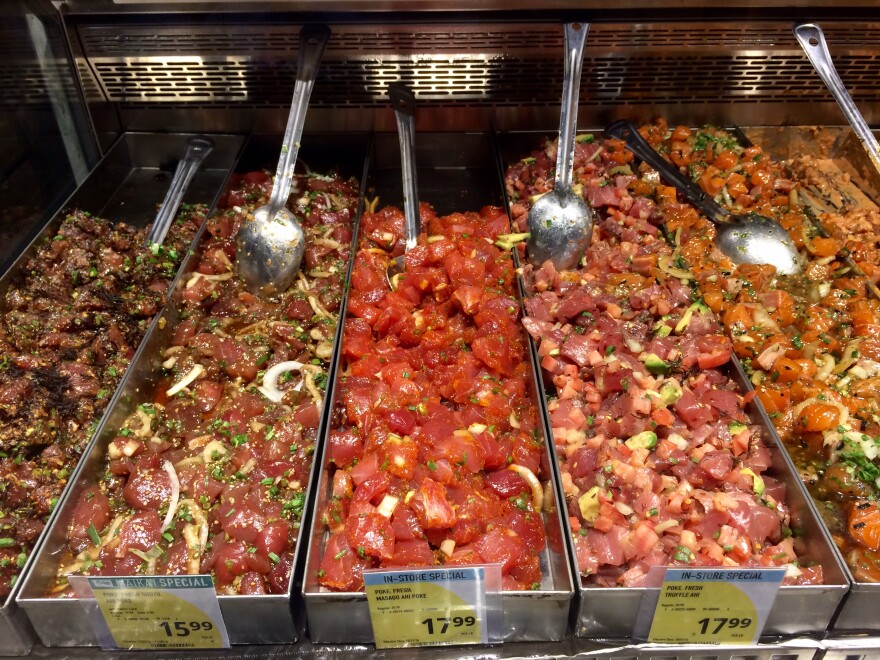According to the Wall Street Journal, poke is one of the culinary trends of 2016. The popular raw-fish dish has taken the mainland by storm, with poke shops popping up across the country. HPR’s Molly Solomon reports on why this Hawaiian staple is gaining a national following.
It’s lunchtime at the Ala Moana Foodland Farms which means a line is beginning to form at the poke bar.
“On any given day we have 30 to 40 varieties, and it can change depending on what’s in season,” said Foodland corporate chef Keoni Chang. He says, these days, poke is everywhere.
“I’m seeing it in all the trade publications. I’m seeing it in all of the food magazines and cooking shows,” said Chang. “It’s really exploded.”

The origin of poke, which literally means to cut or slice, comes from humble beginnings. Traditionally, ancient Hawaiians would harvest and cut up reef fish, seasoning it with salt, seaweed and kukui nuts.
The mainland got its first taste of Hawaiian raw fish a couple decades ago when Hawai‘i Regional Cuisine put the island’s culinary flavors on the map. But it wasn’t until a few years ago that poke shops began to pop up, first on the west coast, and eventually reaching cities across the country from Chicago to New York.
“Part of the appeal could be that as you’re enjoying your poke in Manhattan, you take your bite and suddenly you’re transported mentally to paradise,” Chang said. “So I think there is that romance definitely attached to the item.”
But the mainland has also given the dish a makeover. And some Hawai‘i chefs aren’t happy with the results.
“There’s so much culture, there’s so much story behind it, and I think that it’s just such a huge trend now,” said Chef Mark Noguchi with Pili Group considers the poke trend commodification of Hawaiian culture. He says for local residents, so much of food is wrapped up in identity. He worries that history can get lost when it’s mass produced on the mainland.
“Here in Hawai‘i, the way that we cook, it’s our sense of place. Cooking is such an important facet of who we are, it’s so intimate,” said Noguchi. “You can’t come to Hawai‘i for three months, eat at all the famous poke places, and have an idea of the concept of what we’re about.”

But for others, the popularity of poke has expanded the brand of Hawai‘i to a larger audience. Freelance writer Kathy Chan grew up in Honolulu but has lived in New York for the last 12 years. She says the poke craze has definitely reached the city, with lines often going down the block in Midtown Manhattan. She even saw a few poke shops while doing work in Paris, France recently. But she says the poke bowls they serve are far from traditional.
“In Hawai‘i we would get poke over rice, but here in New York, you can do it over quinoa or over kale salad,” said Chan. “It’s so far removed from what we’re used to eating as poke in Hawai‘i, that I tend not to even think of it as poke when I’m here.”
Chan says initially she couldn’t help but judge this new trend. As a Hawai‘i ex-pat, part of her felt possessive of the local dish.
“When these poke shops first opened, I was like, oh they’re doing this wrong. They’re using crappy fish that’s not as good. But then you get through that stage,” said Chan. “You realize this is making Hawai‘i more popular, it’s helping our tourism industry, it’s spotlighting Hawai‘i cuisine. And in the end, even if it’s not an accurate representation of Hawai‘i food, it puts Hawai‘i on the mind of peoples.”
And for now, poke’s popularity shows no signs of slowing down.




